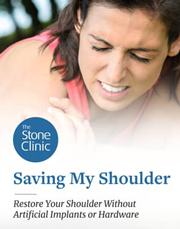Broken Collarbone Surgery Rehab Protocol & Recovery Time
- DO NOT elevate surgical arm above 90 degrees in any plane for the first 4 weeks post-op.
- DO NOT lift any objects over 5 pounds with the surgical arm for the first 6 weeks.
- AVOID REPEATED reaching for the first 6 weeks.
- recommend regular icing routine for the first 2 weeks; please consult Post-Op Icing handout for full details
- An arm sling is used for 4 weeks post-op.
- Maintain good upright shoulder girdle posture at all times and especially during sling use.
- Intermittent X-ray to monitor healing as needed
- M.D./nurse follow-up visits at Day 2, Day 14, Month 1, Month 3 and Year 1 post-op.
Week 1
- MD/nurse. visit day 2 post-op to change dressing.
- Exercises (3x per day):
- Pendulum exercises,
- squeeze ball,
- triceps with Theraband,
- isometric rotator cuff external and internal rotations with arm at side
- isometric shoulder abduction, adduction, extension and flexion with arm at side. -Soft tissue treatments for associated shoulder and neck musculature for comfort
- cardiovascular training such as well arm cycling, biking for Active Recovery
Weeks 2 - 4
- Soft tissue treatments for associated shoulder and neck musculature for comfort.
- Gentle pulley for shoulder ROM 2x/day in limited ROM <90*
- elbow pivots PNF, wrist PNF
- isometric scapular PNF, mid-range
Weeks 4 - 8
- M.D. visit at Week 4 post-op and will usually be progressed to a more aggressive ROM and strength program.
- At Week 4: start mid-range of motion (ROM) rotator cuff external and internal rotations active and light resistance exercises (through 75% of ROM as patient’s symptoms permit) without shoulder elevation and avoiding extreme end ROM.
- Strive for progressive gains to active 90 degrees of shoulder flexion and abduction.
Weeks 8 - 12
- Seek full shoulder Active ROM in all planes
- Increase manual mobilizations of soft tissue as well as glenohumeral and scapulothoracic joints for ROM.
- No repeated heavy resisted exercises or lifting until 3 months.
Weeks 12 and beyond
- Start a more aggressive strengthening program as tolerated.
- Increase the intensity of strength and functional training for gradual return to activities and sports.
- Return to specific sports is determined by the physical therapist through functional testing specific to the patient’s demands
- completion of Sports Test I for initial return to sports and progressive sport-specific training
NOTE: All progressions are approximations and should be used as a guideline only. Progression will be based on individual patient presentation, which is assessed throughout the treatment process.
Don't Know Why Your Shoulder Hurts? Use our Shoulder Pain Symptom Checker to learn more about your symptoms and possible injury conditions.
Need help recovering from surgery? Our StoneFit Physical Therapy San Francisco team can help with customized, one-on-one programs to return you to full activity fitter, faster, and stronger than you’ve been in years.
